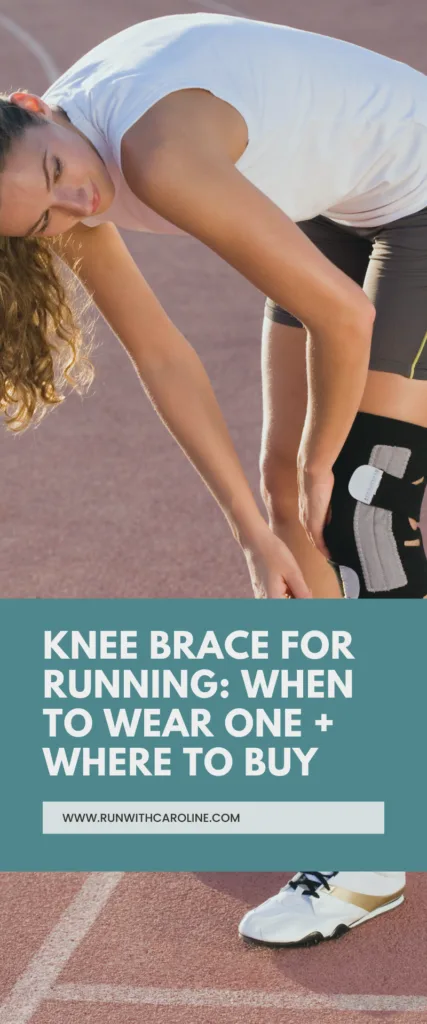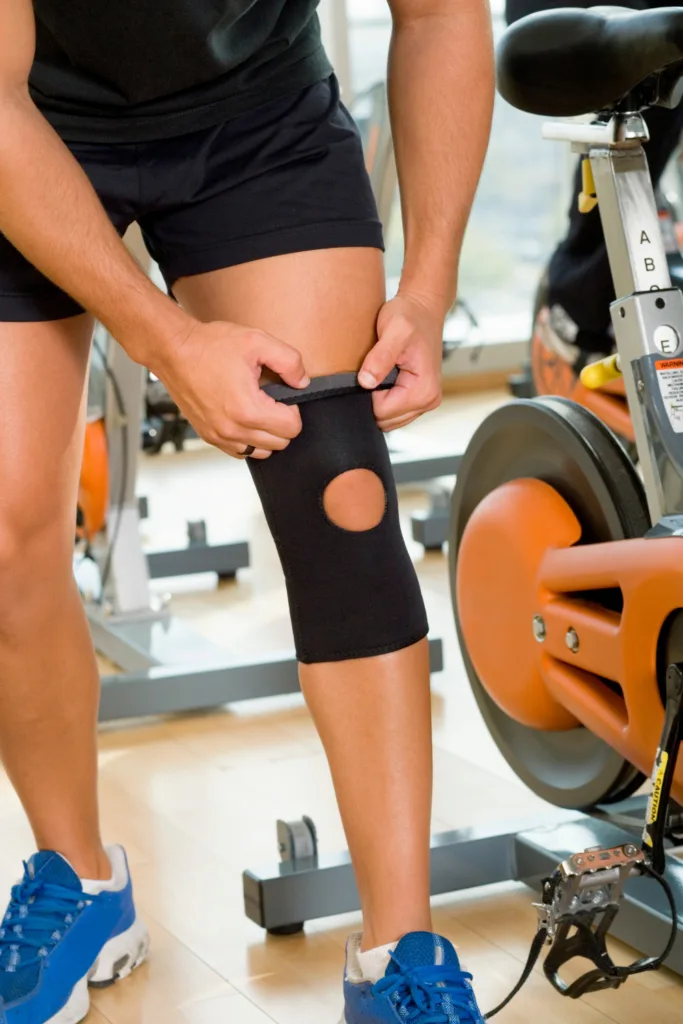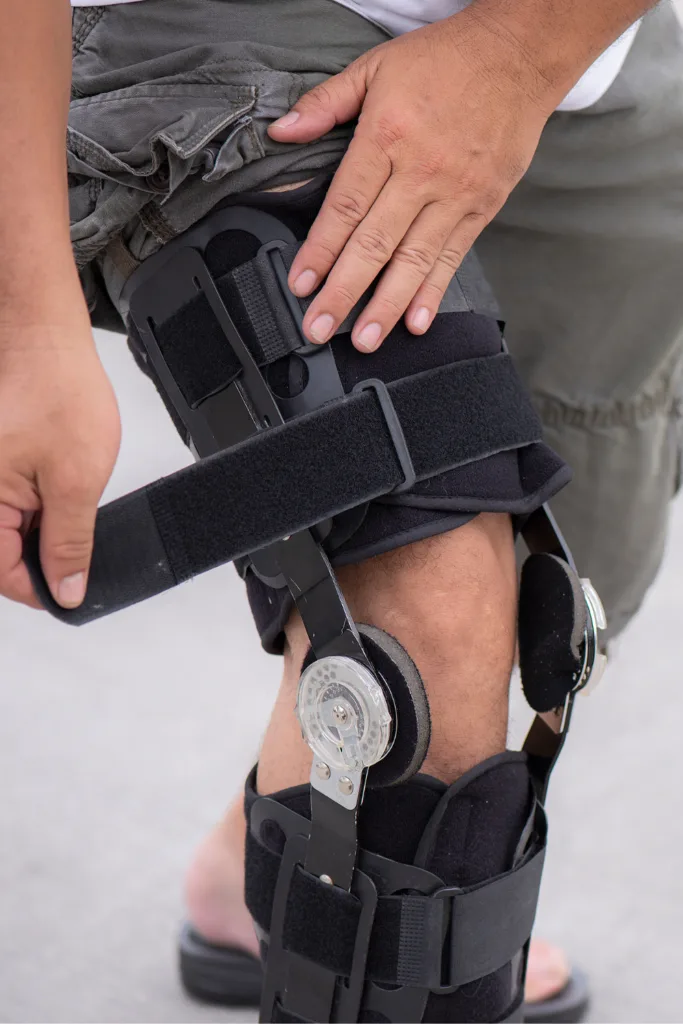Many runners experience knee pain at one point or another in their lives.
Knee pain can range from a dull ache to a sharp stabbing pain that stops you in your tracks.
If you’re trying to recover from knee pain, you may have thought about wearing a knee brace for running.
After all, you want as much support as you can get on your run to avoid making your injury worse.
So what exactly is a knee brace and when should you wear one? Also, where is the best place to buy a knee brace for running?
In this guide we’ll explore:
- What is a knee brace?
- When to wear a knee brace for running
- When not to wear a knee brace for running
- What is the best knee brace for running?
- Where to buy a knee brace for running
- Tips for staying injury free
Ready?
Let’s go!

What is a knee brace?
A knee brace is a form of support that you wear when you experience pain in your knee.
The brace applies pressure to the knee to help alleviate pain and provide extra support and stabilise the knee joint.
Some people wear knee braces to prevent injuries, some wear them for general knee support when performing daily activities.
Whilst others wear them when they are returning to activities following an injury.
Knee braces are made from a range of different materials like metal, foam, plastic and elastic.
They also come in a range of different shapes, designs, colours and sizes.
Related: Knee pain after running: Causes + 10 prevention tips
When to wear a knee brace for running
The general advice is to wear a knee brace if you experience knee pain or if you wish to prevent knee injuries from occurring.
Knee braces can also be worn during injury rehabilitation to provide more support to the knee during the crucial recovery process.
If you had an anterior cruciate ligament (ACL) injury, for example, you may be instructed to wear a knee brace after surgery or treatment.
For the best use of a knee brace, speak to a professional so they can guide you and understand the cause of your knee pain.
Normally, a knee brace is prescribed as a temporary measure alongside some form of physical therapy to correct any issues that led to the knee pain in the first place.
Related: IT band syndrome: How to fix it + 7 training mistakes to avoid
When not to wear a knee brace for running
There are times when a knee brace should not be worn.
If you experience acute pain in the knee or trauma to the knee, such as a twist or tear, then it’s best to speak to a professional to understand the underlying cause.
In addition, if you notice swelling or you cannot bend or straighten out your knee, then these are signs that you need to speak with your doctor.
You will want to avoid wearing a knee brace at all until you identify the cause of the pain and discomfort.
Likewise, if you have been wearing a knee brace for a period of time to help with niggling pain, be careful not to rely on the knee brace too much.
Long term use of knee braces may actually increase the number of knee injuries in athletes.
Related: Overtraining syndrome: 11 signs of overtraining when running

What is the best knee brace for running?
There are so many knee braces on the market nowadays, it can be hard to choose the right one.
You’ll want a knee brace that meets your needs.
Typically, knee braces are categorised into the following three levels of support (1 being the least supportive, 3 being the most supportive):
- Compression sleeve knee brace
- Patellar knee brace
- Medial/lateral support knee brace
#1 Compression sleeve knee brace
These are the types of knee braces that you slip over your knee like a tight sleeve.
Sometimes called soft knee braces, compression sleeve knee braces offer the lowest level of support, but are generally safe to use if you experience any form of pain.
This brace works by compressing the knee and limiting the amount of swelling, therefore improving movement of the joint.
#2 Patellar knee brace
A patellar knee brace works by guiding the knee cap into a more straightened position to take the pressure off the tendon.
They are normally prescribed to treat conditions concerning the patella (the knee cap), such as patellofemoral pain.
Patellar knee braces typically come in three different forms: a patellar tendon strap, a patellar compression sleeve, and a patellofemoral offloader.
#3 Medial/lateral support knee brace
A medial/lateral knee brace works by preventing the knee from caving in and out.
These braces are typically made of strong, hinged materials like plastic and straps.
They are used to protect ligaments of the knee against sprains and tears. They also protect the ACL by protecting against rotational forces.
For meniscus tear injuries, you can also find ‘offloading’ knee braces in this category. They work by taking the pressure off the meniscus after a tear or surgery.
Related: How to recover after a bad run: 8 ways to bounce back
Where to buy a knee brace for running
Now you know more about knee braces, here are our top picks for knee braces for running:
- Best budget knee brace: Boots Adjustable Knee Support (£18)
- Best for protection: Decathlon Knee Brace for Ligament Support (£39.99)
- Best for muscle recovery: 2XU Flex Recovery Compression Leg Sleeves (£45)
- Best for everyday use: Bearhug Running Knee Compression Support Sleeve (£24.99)

Tips for staying injury free
#1 Take care of your body
Remember, knee braces are the least important part preventing knee injuries or healing after an injury.
Good strength and flexibility are much more important when it comes to staying injury free.
Focus on stretching and strengthening the muscles around your knee and in your legs.
Also perfect your running form to avoid muscle imbalances.
#2 Warm up before each run
A good warm up will go a long way to help prevent common running injuries.
Your warm up should consist of light jogging and some dynamic stretches. You may also want to include some running drills.
You should feel energised at the end of your warm up and not exhausted.
#3 Progress slowly
Avoid sudden leaps in your training. Make changes in intensity or training schedules little by little, to limit knee stress.
Work out a training plan that works best for you and your running goals.
#4 Take rest and recovery days
The tendency for a lot of runners is to run every day.
While this may suit some more experienced runners, it’s important you take the appropriate amount of rest days to allow your body to recover and repair itself in between runs.
- 5 things I wish I’d known before returning to running - March 3, 2024
- Running 20 minutes a day: Benefits + how to start - January 27, 2024
- How to run your first 2 hour half marathon - January 16, 2024
